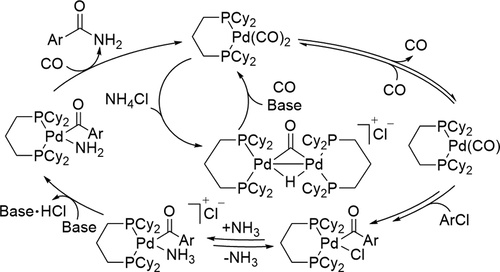Mechanistic Studies of Palladium-Catalyzed Aminocarbonylation of Aryl Chlorides with Carbon Monoxide and Ammonia

Mechanistic information on a reliable, palladium-catalyzed aminocarbonylation of aryl chlorides with ammonia is reported. The reaction occurs with ethylene complex 1 as catalyst, and mechanistic information was gained by isolation of catalytic intermediates and kinetic measurements, including the first mechanistic data on the oxidative addition of aryl chloride to a palladium(0) complex in the presence of CO. Arylpalladium and phenacylpalladium halide intermediates were synthesized, and kinetic measurements of the formation and reactions of these intermediates were undertaken to determine the mechanism of the oxidative addition of aryl bromides and chlorides to a Pd(0) dicarbonyl compound in the presence of CO and the mechanism of the reaction of ammonia with a Pd(II) phenacyl complex to form benzamide. The oxidative addition of aryl chlorides and aryl bromides was determined to occur with rate-limiting reaction of the haloarene with a three-coordinate Pd(0) species bearing a bidentate phosphine and one CO ligand. A primary 13C kinetic isotope effect suggested that this step involves cleavage of the carbon–halogen bond. Our data show that the formation of benzamide from the reaction of phenacylpalladium halide complexes with ammonia occurs by a pathway involving reversible displacement of chloride from a phenacylpalladium chloride complex by ammonia, deprotonation of the bound ammonia to form a phenacylpalladium amido complex, and reductive elimination to form the C–N bond. Consistent with this mechanism, the reaction of an aryl palladium amido complex with CO formed the corresponding primary benzamide. A catalyst deactivation pathway involving the formation of a Pd(I) dimer also was elucidated.
Read more on publisher's site.